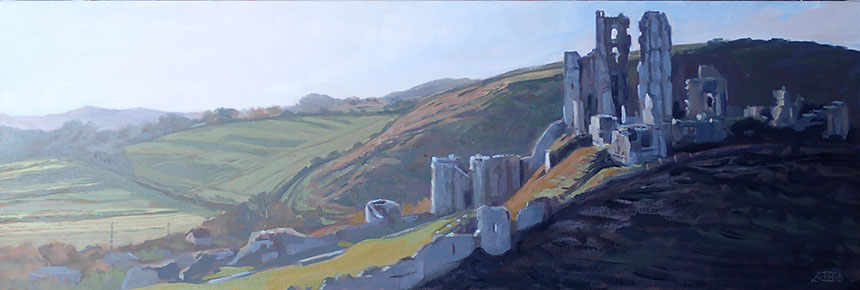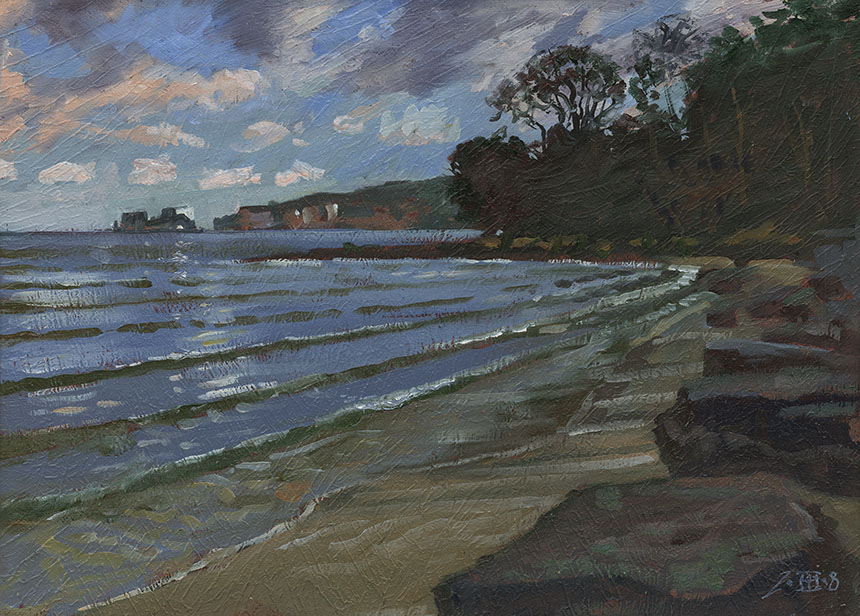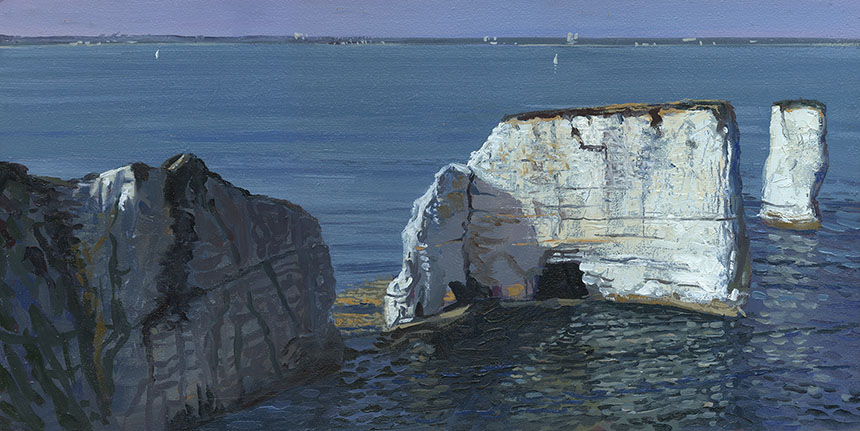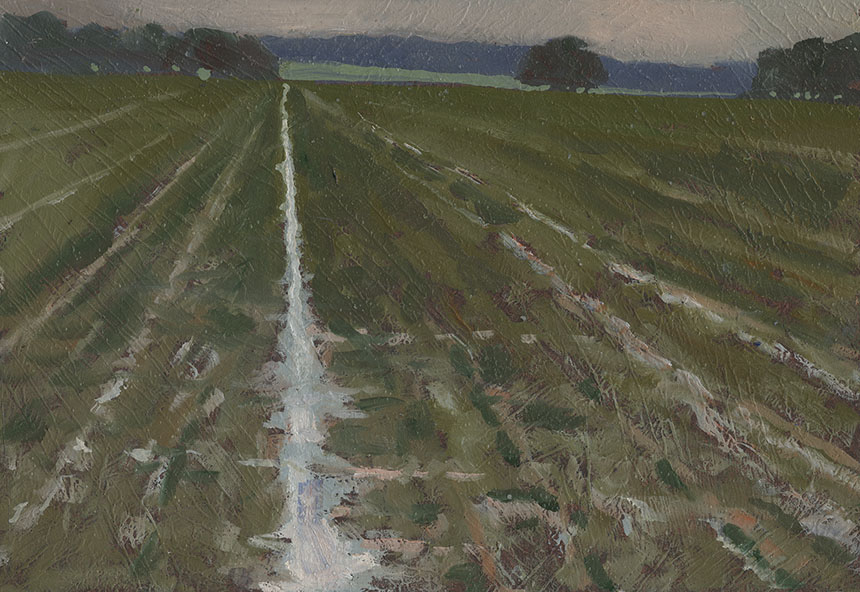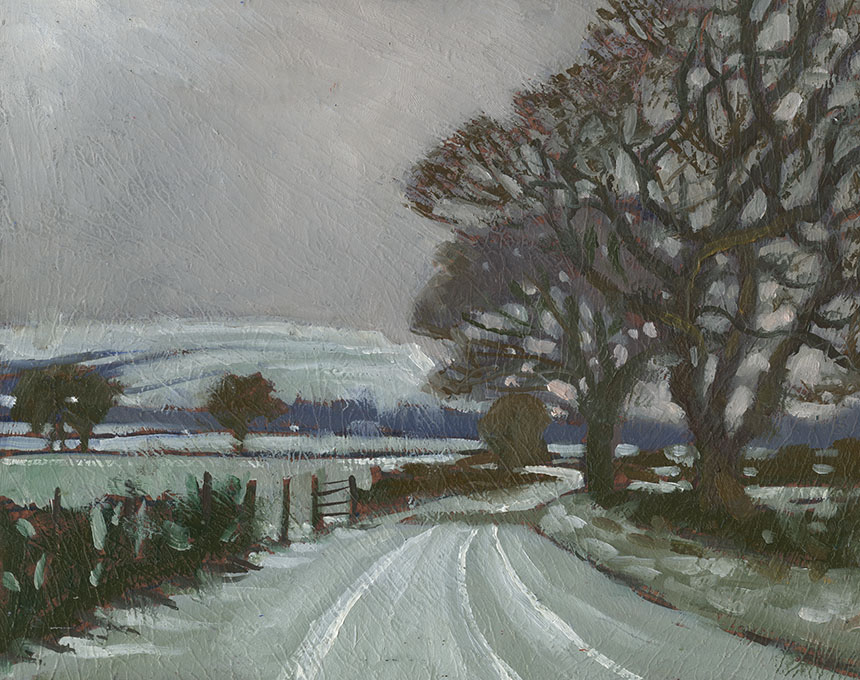We all know when a painting has gone very wrong, mostly we are pretty clear when we have triumphed against the odds. Which leaves all the ones that fall somewhere in-between. I have been reviewing my oil paintings for the year and reckon that out of about 140 oil paintings 33 fall into the successful bracket. 40 fall into the sand them off and reuse the board category. I must note that the truly cataclysmic ones got wiped off immediately! This is the way it is if you mostly paint plein air, you just have to accept that any day out painting has only a 30% chance of producing a decent painting. Anyone doing the maths on the above will conclude that 60 odd pictures fall into the, “Not completely sure about this one.” bracket.
So how do I judge whether it’s a goodun or a baddun or an inbetweenun? I wish I could say and promptly type in a wise, pragmatic rule of thumb method of assessing your own efforts to help beginners and others who meet the same issue. Well I can’t. I find it excruciatingly difficult to judge my own paintings outside of the very obvious winners and losers. I can always see good bits and so so bits in any painting I do, but often what stops the whole from working is extremely hard to pin down. It might be so underlying like a boring composition, so you have a decently painted but unexciting picture. Some are a little easier in that they have a part that is either distracting from or otherwise letting down the rest of the show. These go on my surgery pile. The really hard ones are the ones that there is something worrying me about it but I cannot put my finger on what might make the painting come to life.
How about, “Ask a friend.”? Well another brave painter I know made a Facebook group where we can put up the puzzlers and have another less emotionally involve eye assess the problems. I had previously floated this idea myself and received such sweepingly negative feedback that I didn’t do it myself. Painters it would seem are nervous of the opinions of others and would prefer not to hear. I am not unsympathetic with this as in my teens and early 20’s before I worked in the commercial arena if anyone voiced a doubt on any drawing I would immediately rip it up. Thank heaven I next worked on commercial jobs where the option wasn’t a practical possibility and in the commercial world you would receive negative feedback as a matter of course. Fortunately this soon broke me from a childish habit. At first I would argue with the client, but in later years this was reduced to a brief whine and a sulk!
So why are we so touchy? I think it is because in daily life to get on with each other we try to be polite. If you go to dinner and the host’s cooking is less than the full Delia Smith we smile anyway and lie about how much we are enjoying it. You always answer the, “What do you think of my new hairdo?” question with a peon of praise rather than mentioning that you have seen more stylish mops propped up in janitor’s buckets. We know instinctively it is kinder to let such poor souls continue life in a happy delusion rather than force them rudely into depressing reality. So it is with pictures and painters.
I have over the years tried various cunning methods of slipping a helpful suggestion past someone’s guard. One is to heap praise on various other aspects of the daub before mentioning the defect. It doesn’t work. You could spend an hour outlining the genius of the painter, the astounding masterfulness of every aspect of the work, you can bemoan your own inadequacy and express envy at their having painted such an astounding picture that the whole of western art might have to be rethought. This will all be received with an ever smugger expression or various insincere, “Oh you are just saying that!” and “Surely not.” protestations.
Then you say, “It’s only a tiny, tiny thing but I’m not too sure about that slash of bright yellow in the foreground…”
As the “but” hangs in the air the sunshine immediately darkens and thunderclouds roll in. The previously cheerful bubbling springs promptly dry up and the warm limpid pools before them freeze over. The ice that has instantly appeared under foot cracks menacingly. If any piano is playing at that moment it ceases leaving a discord hanging in the air and every head in the vicinity turns towards you. You look down and like Wile E. Coyote you have walked off a cliff and the canyon bottom is 2000ft straight down. Yes the mood has changed, all the positives evaporate like spit on a red hot frying pan. You have dared to be NEGATIVE. As we all know it is now a sin to be negative in any way. Positive thinking is espoused in books devoted to the subject. I used to go to brainstorm meeting where any negative comment was forbidden however stupid the idea put forward. Any possible failure must be described as “deferred success”.
All this is a pity really. We still have advice and criticism of course, but this must be in a clearly defined “teaching” context. So the best advice I can offer here on this subject is to learn to put some kind of emotional distance between you and your work. I know. I know. Your work is the expression of your innermost soul and you have torn off your skin to expose your quivering flesh to the unkindness of existence. None the less a little emotional distance will allow you to determine whether you have painted an existential cry of despair from a primeval man trapped in a mechanised universe, or a pitiful squeak from a pampered mammal in the grip of affluenza.
I have had this 36in by 12in canvas stretched up for a while… it even had a frame but I couldn’t quite come up with anything to paint on it! I decided in the end on this wide view of Corfe. What I attracted me to it was the way the tones that described the light subtly changed from left to right. I arrived at its current state intending to go further but in the end decided not. If I hadn’t had the frame to check the effect in I might well have resolved it more. Oils.
A great day out by the sea. This is Studland Bay. The tide was lapping at my boots by the time I finished! The underside of the waves was the most intriguing tone and I had to have several goes at mixing it. 14in by 10in Oils.
I toiled out through the mud to Dancing Ledge after, only a sketch really as the time and light was rapidly on the move. I took a set of photos as the light fell away which might make a studio picture in due course. Sometimes there is no real time to consider composition, if I had had more time I would have walked too and fro to check different aspects of the scene, in real life though if I had actually done that the light would have gone and I would have had no painting at all. It is a bit of coast I need to walk this bit of the coast more so I know which bits might make a good painting. If the light is looking good you can then go directly to the spot with no messing! 16in by 10in Oils.
This is Beaminster on a beautiful crisp morning. I was perched on an awkward corner with the passing Range Rovers trying to drive over my toes. After doing this I promptly came across a better view just round the corner. I might come back to this one though, I quite fancy trying to get a square crop. The sky was the most amazing flat blue, I was temped to add some clouds but in the end just left it as it was. 12in by 10in Oils.
Up in the hills a bit south of Beaminster, lovely slanting light that was only there for a moment then gone. I soldiered on anyhow but really I was painting a fading memory rather than what was in front of me. I should have just stopped and restarted! 14in by 10in Oils.
Entertainment for a wet afternoon. I couldn’t settle down to paint so I set about preparing a few boards. I had one which was of Lyme Regis that I had had hopes of and even made a frame for but I couldn’t get it to work from the information I had. So I sanded off Lyme Regis and as I did so a ghost of Old Harry rocks appeared. I then remembered I had started en plein air blocking in a picture of Old Harry on this board… having blocked it in I decided I didn’t like the composition… and started again on a 16in by 10in board- hence the ghost. My studio self quite liked the wider view so I dug out the photos from the day and set to. I remember struggling with the chalk cliffs on the other version so I experimented with using the knife on this one. I rarely use a palette knife except to scrape back so I am not as deft with the instrument as I might be. One reason I don’t often use a knife to apply paint is I don’t like impasto in dark or shadow areas, so I just used it in the lightest areas in the centre of interest. I found it hard to shake off the memory of the previous painting but quite pleased with the result. 20in by 10in Oils.
The day before painting this I had walked up on Hambledon Hill with a friend and noticed the light was perfect for painting. So as the next day was sunny I ascended at the same time with my paints. The light was glorious but the wind meant I had to hang on to everything as I painted. Still I rather like this viewpoint, it is harder than you might think to get a satisfactory picture out of the hill. It is so expansive and dramatic that you always feel you have failed to catch its essence. 16in by 10in Oils.
Snow at last! This is the slightly surreal Shillingstone Station. The line is long gone so it only has a 200 metres of track. I found I had made a slightly painful choice as it was rather exposed as you can see by the snow blown in lines across the platform… Also there was fine snow blowing in the wind that got over everything. Due to all this I only got 20min before it got too painful and I had to escape, still after a tidy up it has an interesting atmosphere the light is quite unique in a blizzard! 10in by 6in Oils.
A view across the fields on my way back to Child Okeford. I liked the way the wind had blown the powdery snow into any dip, bringing out the shapes in the ground. I did this in a very brisk 15 min as conditions had got worse and the snow was threatening a genuine blizzard! 10in by 7in Oils.
I wasn’t going to do another but saw this odd line the path made in the field and thought I could get it down quickly. Ha! It longer than both the others and I nearly died of the cold. Painting large areas of nothing much is the hardest thing to do and the field seemed to take forever. Still the effort was worth it as it is my favourite of the day. 10in by 7in Oils.
It had well and truly snowed overnight so I had to go and attempt to paint it. I didn’t think I would be able to get to paint Fontmel Down as the roads were very bad, but heroic farmers had cleared some roads up the hill and my car is a 4 by 4. I had thought the painting on the station was painful but this was on another level. The cold wind was like having knives driven into my face! All I could manage was to block in the basic tones before I ran whimpering back to the car. Mind you the great thing with snow is the way it simplifies the scene so it did not take a great deal to finish off. I’ll do a studio one of this I think as would like a wider view. 10in by 6in Oils.
Last snowy one. On my way back with the snow threatening to close in again I saw this and after checking the wind decided to give it a go. After drawing out I blocked in all the snowy bits whilst carefully leaving any dark areas uncovered. Once done the painting looked more or less complete so I packed up and added a few brown and purply tones over the remaining bits of ground back in the studio. The warm priming works surprisingly well for snow pictures. On all of these I blocked in the pale tones leaving the darks. I takes a little longer leaving the darks but looks much better than trying to lay the darks over underlying lights. 10in by 8in Oils.
